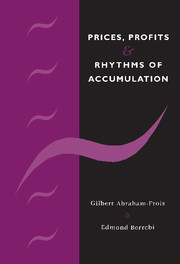Book contents
- Frontmatter
- Contents
- Preface
- 1 The golden rule of accumulation and prices
- 2 Systems of production prices
- 3 Irregular and decomposable systems
- 4 The analysis of joint production
- 5 Standards and blocking goods
- 6 Labour values and the problem of transformation
- 7 Switch in methods of production
- 8 The dynamic evolution
- Notes
- References
- Index
4 - The analysis of joint production
Published online by Cambridge University Press: 06 July 2010
- Frontmatter
- Contents
- Preface
- 1 The golden rule of accumulation and prices
- 2 Systems of production prices
- 3 Irregular and decomposable systems
- 4 The analysis of joint production
- 5 Standards and blocking goods
- 6 Labour values and the problem of transformation
- 7 Switch in methods of production
- 8 The dynamic evolution
- Notes
- References
- Index
Summary
The analysis carried out in the previous chapter was restricted to single-product industries and circulating capital. It is not because we consider simple production as the rule and joint production as an exception that we have first comprehensively developed simple production models. It is rather for simplicity's sake, and this allowed us to obtain concise and elegant results from the assumption of system productivity alone.
In fact, the general rule is joint production and Steedman (1984) has listed the processes of joint production that can be encountered in various sectors of the economy, such as agriculture, fishing, chemistry, electricity, petrol, transportation, communications, etc. The emergence of fixed capital, of machines, in models of production also requires a joint production framework of analysis.
The analysis of joint production systems cannot be carried out without mentioning the phenomenon of truncation, or the suppression of methods of production. Analysing a specific system of joint production means assuming that supply is in conformity with demand and that there is no excess production; it also means that problems of efficiency, revealed by negative prices, have been solved.
Such issues have already been contemplated in the first chapter, and the issue of switch in methods of production will be dealt with in detail in chapter 7, so it is not taken into account in the present chapter: production systems are taken to be square, which means that unprofitable activities have been eliminated as well as the excess supply of goods. It is in this particular framework that we shall specify the determination of prices in joint production systems.
- Type
- Chapter
- Information
- Prices, Profits and Rhythms of Accumulation , pp. 100 - 126Publisher: Cambridge University PressPrint publication year: 1997



